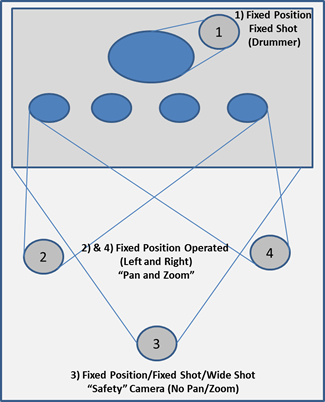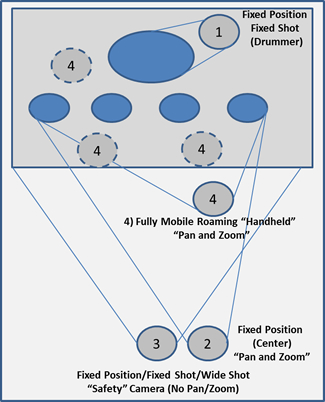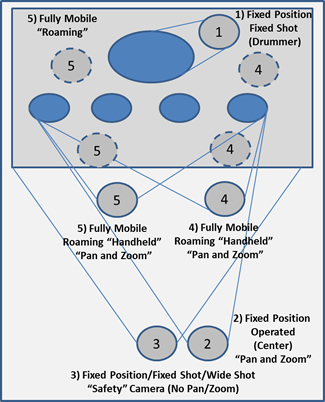An important element of live event video production is the number of cameras used and where to place the cameras. Part of this consideration is whether those cameras will be “fixed” in place or controlled by a live operator that will “pan and zoom” the camera to focus on key content. To capture quality material to effectively edit into a full show, a combination of “hand held” actively operated cameras and fixed cameras will be required. The goal is to make sure you don’t miss any of the show and to get solid shots of important events in the show for later editing.
The optimum number of cameras is influenced by multiple factors:
- Number of Performers – more performers on stage might require more cameras just to cover all of the action on stage. There is always the thought of dedicating a camera for every performer, but that is usually excessive (and creates even more work when you are editing the sequence into a complete show – more on that in the article on editing).
- Location of performers – Larger stages or stage arrangements might make it difficult to capture all of the action with a small number of cameras – especially if performers are separated by long distances.
- Musical Arrangements – more complex arrangements might require more cameras to capture significant moments – so they can be edited together later.
- Available camera operators – there is always the consideration of finding qualified people to run the cameras. They need to know something about the cameras, have decent ability to frame and maintain a shot, and even be somewhat physically fit – depending on the camera position they are supporting.
Major Types of Camera Positions/Locations:
- Fixed Position Cameras – Cameras that are typically mounted on tripods, set to a fixed shot and pretty much left alone during the show. While these cameras can be left on their own, it’s always good if someone is able to check on these cameras – to make sure they have not been bumped by a fan or gone out of focus for some reason.
- Fixed Location “Operated” Cameras – While these cameras are fixed in physical locations on tripods, they are more actively operated cameras – with the operator “zooming” and “panning” to capture key action. It’s important that these cameras are operated by someone fairly knowledgeable about the camera and someone with a bit of physical endurance. It might seem like a simple task, but holding, aiming, and manipulating a decent size camera for a period of 60 minutes or more can wear people out.
- Fully Mobile “Roaming” Camera – to make sure you can capture those great close-ups, break up the angles, and obtain a nicer variety of shot, it’s important to have at least one fully mobile operator. This camera needs to be operated by someone with good knowledge of the camera and also with a great degree of physical endurance and strength – as this operator will likely be climbing on stage and running around the stage to capture key shots. In addition, this operator should also not be shy – as they will typically need to climb up on the stage and stand in front of the audience in order to capture the needed shots. Save the shy operators for monitoring the rear camera or running one of the “fixed” locations. Because this camera is the one that can move to capture any shot, it is a very critical camera. If you cannot afford to have two forward stage cameras, it is often better to have one front fixed camera and one fully mobile operator.
Specific Camera Locations/Types:
- Fixed: Rear Wide Shot “Safety” Camera – To be sure to capture all critical parts of the show, it’s good to set up a fixed camera at the rear of the venue that can capture all of the action on the stage as a wide shot. Worst case (if all other cameras are busy or missed a shot, you can always fall back to use the fixed wide shot as a “safety shot.” This rear shot also provides an effective shot used in editing to balance the pacing and provides a good effect (more on that in the articles focused on editing the captured content).
- Fixed: Camera on the Drummer – When editing the material later into a complete show, this camera location provides an excellent shot to highlight the music, increase the energy of the show (using fast cuts to highlight drum fills and other “hits,”, and generally break up the other shots in the edit. Typically, this camera can be mounted on a tripod and angled slightly up to see the drummer and most of the drum set.
- Fixed/Operated: Left and Right Side Front Cameras – The most common position for these cameras are in front of the stage – one on the left and one on the right. This way, each camera can capture performers that are straight ahead or they can capture cross stage shots – breaking up the angles – making the resulting edit more interesting. Ideally (if you have the number of operators available), these positions can be mounted on full tripods and the operators can “pan and zoom” as needed using a fluid head tripod (more on that in the article on equipment later).
- Fully Mobile “Roaming” Camera – One or two “roaming” cameras usually provides sufficient coverage to capture all key action on stage. These cameras/operators can be located primarily on stage or move around as needed to capture different angles and get extreme close ups.
Example 1: Four Fixed Position Cameras
 This configuration consists of four separate cameras, all of them are fixed in location (in other words, mounted on tripods).
This configuration consists of four separate cameras, all of them are fixed in location (in other words, mounted on tripods).
Camera 1) is fixed on the drummer and will be a constant shot for the duration of the show.
Camera 3) is the “safety” camera, capturing a wide shot of the entire stage and will be a constant shot for the duration of the show.
Cameras 2) and 4) are fixed on a tripod, but are actively operated to “pan” and “zoom” to capture close up shows and highlight the action.
Since cameras 3) and 1) are fixed, there is no coordination needed to determine what shot they will capture. Cameras 2) and 4) will need to establish an understanding of what action should be captured from each camera. (More on this in the article discussing camera synchronization and capture strategies).
Example 2: Three Fixed Position Cameras and One “Roaming” Camera
 This configuration consists of four cameras – three are fixed on tripods and one is fully mobile to move around the stage. As in configuration 1, two of the fixed cameras also have a fixed shot, while the other fixed camera is operated to pan and zoom on the action.
This configuration consists of four cameras – three are fixed on tripods and one is fully mobile to move around the stage. As in configuration 1, two of the fixed cameras also have a fixed shot, while the other fixed camera is operated to pan and zoom on the action.
Camera 1) is fixed on the drummer and will be a constant shot for the duration of the show.
Camera 3) is the “safety” camera, capturing a wide shot of the entire stage and will be a constant shot for the duration of the show.
Cameras 2) is fixed on a tripod, but is actively operated to “pan” and “zoom” to capture close up shows and highlight the action.
Cameras 4) is a fully mobile/hand-held camera that can move around the front of the stage and even up on to the stage to capture selected closeup shots and capture unique shots. Since the camera is mobile, it can capture shots of the keyboard player (as direct shots of hands playing the keys), different angles of the drummer (that can be edited with the fixed drummer camera to create powerful edits during highly syncopated sequences), or closeups of guitar or bass players to highlight both the music and the musician. The operator of this camera should have good physical endurance (as they will be carrying a camera around while they climb up on stage and run around the venue).
Since cameras 3) and 1) are fixed, there is no coordination needed to determine what shot they will capture. Cameras 2) and 4) will need to establish an understanding of what action should be captured from each camera. (More on this in the article discussing camera synchronization and capture strategies).
Example 3: Five Cameras – Three Fixed and Two “Roaming” or Hand-Held
 This configuration consists of five cameras – three are fixed on tripods and two are fully mobile to move around the stage. As in previous configuration, two of the fixed cameras also have a fixed shot, the other fixed camera is operated to pan and zoom on the action, and two a fully mobile.
This configuration consists of five cameras – three are fixed on tripods and two are fully mobile to move around the stage. As in previous configuration, two of the fixed cameras also have a fixed shot, the other fixed camera is operated to pan and zoom on the action, and two a fully mobile.
Camera 1) is fixed on the drummer and will be a constant shot for the duration of the show.
Camera 3) is the “safety” camera, capturing a wide shot of the entire stage and will be a constant shot for the duration of the show.
Cameras 2) is fixed on a tripod, but is actively operated to “pan” and “zoom” to capture close up shows and highlight the action.
Cameras 4) and 5) are fully mobile/hand-held cameras that move around the front of (or on) the stage to capture selected closeup shots and capture unique shots. With two mobile cameras, it should be possible to capture most of the dynamic action on stage. Similar to the previous configuration, these operators should have good physical endurance and knowledge of the cameras.
Since cameras 3) and 1) are fixed, there is no coordination needed to determine what shot they will capture. Cameras 2), 4), and 5) will need to establish an understanding of what action should be captured from each camera. (More on this in the article discussing camera synchronization and capture strategies).
Currently Posted:
- Background – A Simple Approach to Concert Video Production
- Live Event Production: Real-time or Post Production Editing
- Number of Cameras Needed and Camera Placement Options
- Atlanta Rhythm Section: Live at the Stabler Arena (Example Production)
- [VIDEO] Atlanta Rhythm Section: Live at Stabler Arena – Back Up Against the Wall
Other articles coming soon:
- Video Capture and Camera Use – Framing the Shots and Just What to Capture
- Coordinating and Synchronizing Video from Multiple Cameras
- Types of Cameras Available – Pros and Cons
- The Importance of High Quality Audio – How to Capture High Quality Audio
- Multiple Camera Video Editing
- Editing System Options
- DVD Replication and Duplication
- DVD Authoring
- Distribution and Marketing Options
